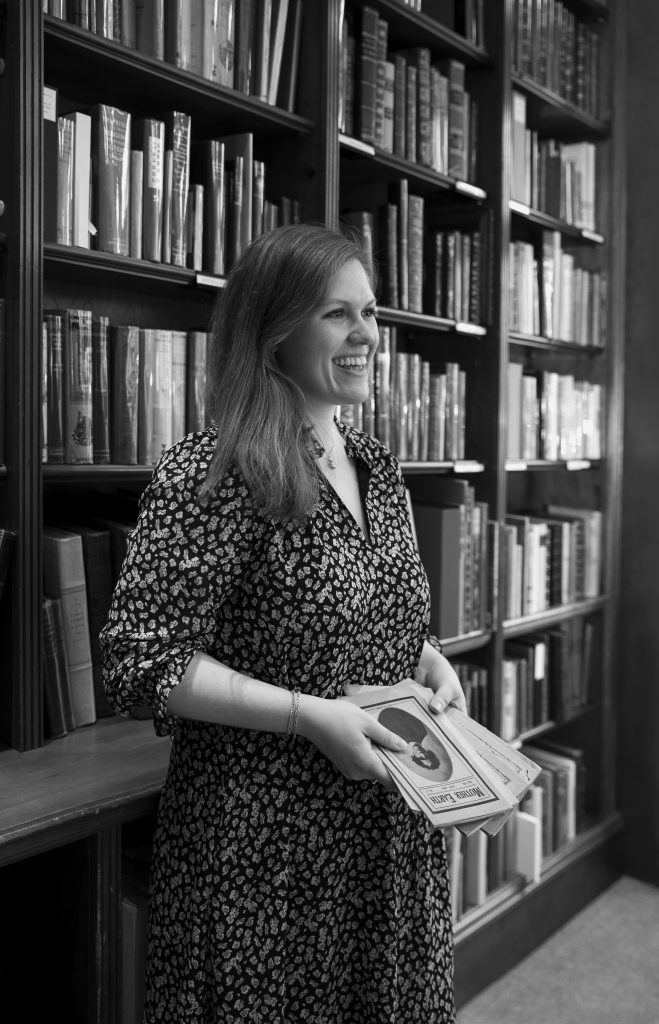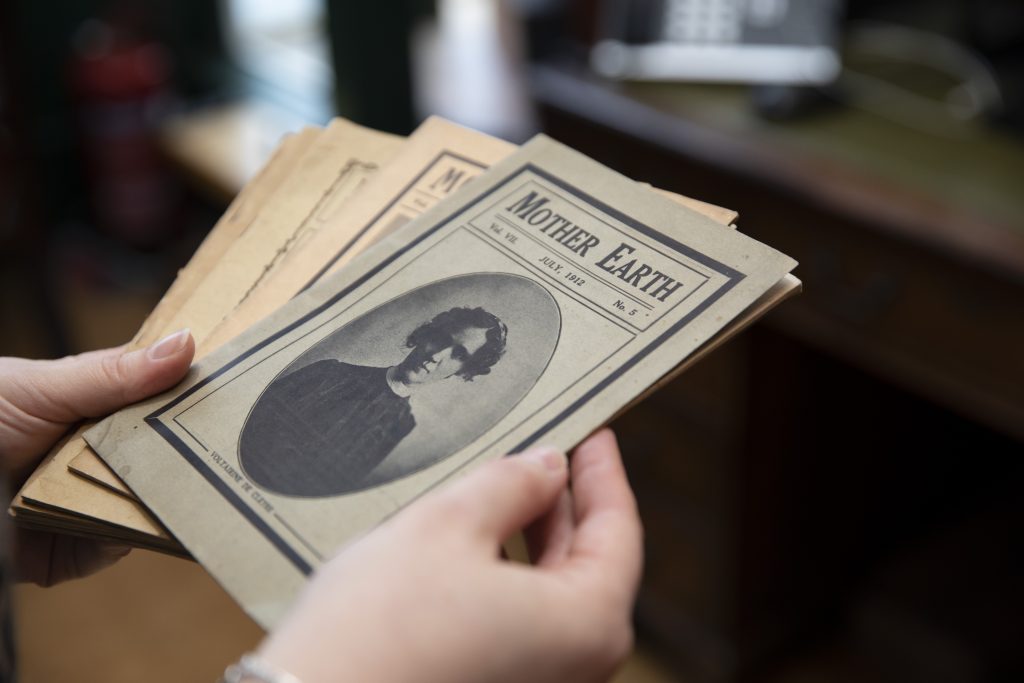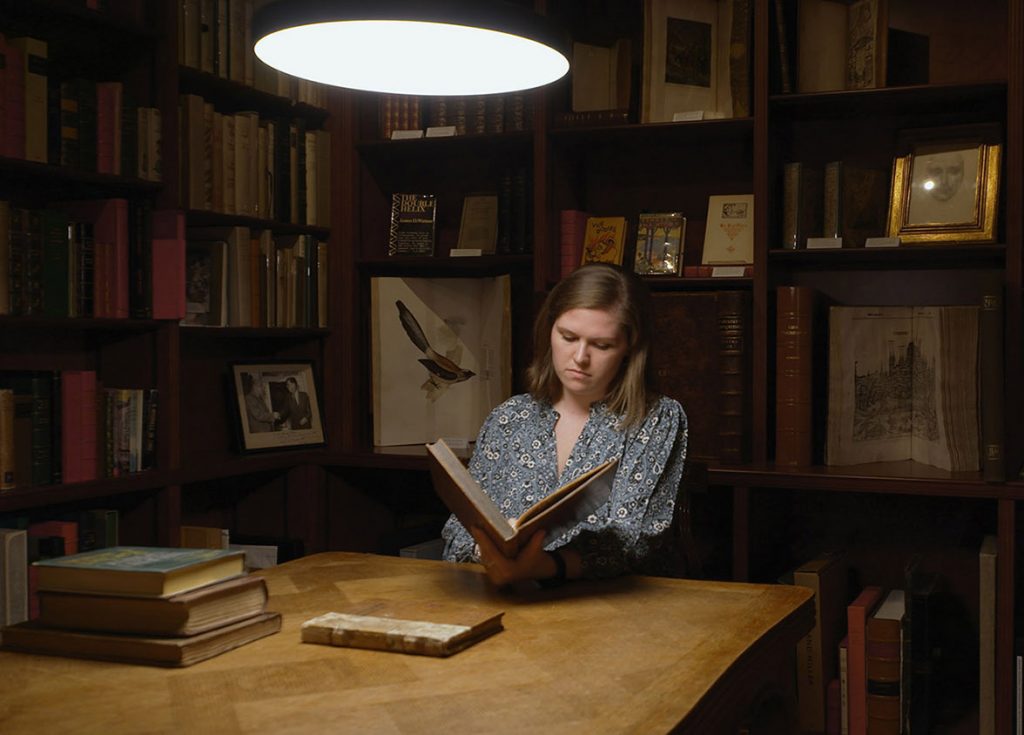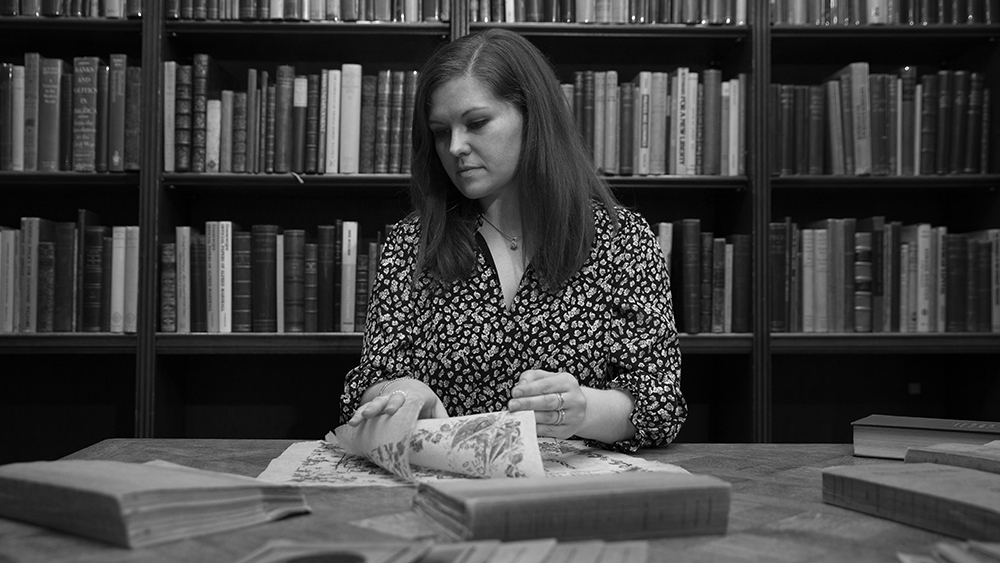Cataloguer Emma Walshe shares her journey into the rare book world and some of the projects she’s worked on at Peter Harrington.
Interview by Winifred Hewitt-Wright
I would love to know about how you came to work at Peter Harrington, can you tell me a little bit about that?
It was quite a winding road – I knew exactly what I didn’t want to do, career-wise, so I worked backwards from there. After completing my degrees in English, I took on a series of fixed-term positions in the arts and heritage sector, working in history of art departments, artists’ archives and libraries, at auction houses, and for digitisation projects. I was hoping to find a job where I could apply my academic interests in a more hands-on, commercial environment. When I saw the advertisement for a cataloguing and bookselling position at Peter Harrington, it seemed like a smart blend of those two worlds.
What does your day-to-day work at Peter Harrington look like?
It’s super varied. Most of my time is spent at our Fulham Road shop, sourcing and cataloguing books and manuscripts for stock, which involves combing the web, reading trade and auction catalogues, and discussing potential acquisitions with colleagues. Sometimes I’m coordinating our auction coverage, other times I’m proof-reading an upcoming catalogue, attending book fairs, or installing libraries for our customers. It’s not an exaggeration that I learn something new every day, and I love that the job requires you to pivot between all kinds of different topics and materials.
 Do you have any advice for people wanting to enter the trade?
Do you have any advice for people wanting to enter the trade?
I think it helps to be flexible and to think creatively about how you can gain transferrable experience. I didn’t know the rare book trade existed when I first started looking for jobs, and it took me a few tries to get in once I did. Don’t be discouraged if you can’t immediately find an internship or open position. Be persistent, read lots, and do your research. Also, languages are very useful – I wish I had a better command of those.
Are you in search of any acquisitions currently which really interest you?
We’re planning to publish a second Works by Exceptional Women catalogue in 2023, so I’m always looking for special pieces for that. At the moment, I’m working to expand our science stock and reading up on the history of data visualisation in particular.
You work primarily in the fields of Science and PPE, what intrigues you most about these subjects?
Science, technology, philosophy, politics, economics – together they form the backbone of the history of human thought. I like understanding how people arrived at ground-breaking discoveries and paradigm shifts, driven by curiosity, ambition, and trial-and-error approaches. Plus, it’s fascinating to see how their influence permeates everything around them: literature, fine arts, even social movements. I also came to these subjects relatively fresh, so there’s always another strand with which to start from scratch.
Are there any areas of interest that you have identified as enjoying particular interest with customers recently?
With the rise in interest in cryptocurrencies, we have had a few customers ask after related rare books. It’s been interesting to reconsider famous economic bubbles in history and the speculators who jump-started them – John Law and his revolutionary approach springs to mind – as precursors to today’s innovations.
Recently you have put together a list of curated material for our climate change collection. What was your biggest challenge?
At the outset, my understanding of the history of climate change and environmentalism was fairly basic, so it was a steep learning curve. I started by sketching out timelines, assembling a bibliography of key names and works, and identifying major turning points in history, whether in scientific advancements, policy changes, or public opinion. The next hurdle was looking at all that information and working out the viability of building a rare books collection around the topic. What was known to the market already and what had never surfaced? Where did the value lie? Where do you draw the parameters? It was a challenge, but a creative and rewarding one.
 It’s fascinating to think about the history of scientific inquiry surrounding climate change. What is the earliest example of a document that acknowledges its existence?
It’s fascinating to think about the history of scientific inquiry surrounding climate change. What is the earliest example of a document that acknowledges its existence?
Describing something as “the earliest” or “the first” of its kind is always a minefield – experts inevitably quibble over priority, or previously forgotten works resurface and are assigned a new status. An excellent case in point is the 1856 article on greenhouse gases by Eunice Newton Foote, the rediscovery of which has prompted an entire re-evaluation of the study of the greenhouse effect in the nineteenth century.
Bearing all that in mind: the earliest item in the collection is a beautiful incunable from 1485, one of the very first printed collections of weather predictions. Our modern understanding of climate has its roots in these kinds of formative meteorological works – even if their authors wrote about a very different concept of “klima” to the one that we recognise today. It’s exciting to see evidence of concern for the natural world and our place in it at the dawn of the age of print.
The eighteenth and nineteenth centuries saw a flurry of important “firsts” around climate change. Alexander von Humboldt emerged as the first scientist to conceive of the planetary ecosystem and to develop the idea of human-induced climate change. The experiments set up by Foote and her colleagues prompted all kinds of new conclusions about carbon dioxide. In 1899 Nils Ekholm was the first to apply the greenhouse metaphor to the phenomenon.
It isn’t really until the late twentieth century, however, that we see science translated into action on an international scale, with a different series of “firsts”, such as the first official briefing on the environmental risk of carbon dioxide (1965) and the first comprehensive assessment of global climate change (the Charney Report, 1979). The collection includes first editions of all of the above titles, and then some.
 In your opinion, what is the most impressive text from the collection?
In your opinion, what is the most impressive text from the collection?
To me, some of the most impressive items are those that pair text and visuals to illustrate the sheer impact that humans have upon the Earth. Sometimes it’s hard to parse the avalanche of data on climate change, so visuals can be vital to our understanding of and engagement with the crisis. The detail of the large, engraved folding “Naturgemälde” plate in Humboldt’s Ideen zu einer Geographie der Pflanzen (1807) is staggering when seen in its entirety. The coal diagram in Dudley’s Mettallum Martis (1665), the earliest account of the use of fossil fuels in iron production, is simple in design but no less ground-breaking for it. Keeling’s 1976 report from the Mauna Loa Observatory in Hawaii conclusively confirmed the rapid increase of global atmospheric carbon dioxide levels, and the diagram illustrating this discovery remains one of the most iconic (and damning) visualisations of climate change.
How important was it for you to have climate change at the forefront of one of Peter Harrington’s collections/campaigns?
I think there is real value to approaching the climate emergency from all kinds of different angles. Sure, the rare book trade can’t “solve” climate change, but what it can do is use the platform it has to lend a new perspective to the matter and encourage greater awareness and action. When we buy and sell books, we have an opportunity. We can promote important issues like climate change, demonstrating just how long writers, scientists, artists, and activists have been gathering evidence, vocalising anxieties, and taking action. We can re-evaluate well-known texts in a new light; we can elevate previously undervalued areas of scientific inquiry. Peter Harrington was in a unique position to assemble extraordinary material on the topic, and our public exhibition of the collection coincided with the COP26 summit last year. It felt important to do something meaningful with that opportunity. And I think, as a project, it chimes with the ways in which the company is working towards being more eco-conscious.
How long did you work on the collection in total, and do you believe the hard work paid off?
It took about three years to assemble the collection. I think it is a testament to the hard work of many, yes – not only us at Peter Harrington but also the efforts of those that we collaborated with. I’m thinking of Dave Wenner, the American collector whose scientific material and expertise made an invaluable contribution to the collection, and of award-winning wildlife documentary producer John Ruthven and his team, who created our ten-minute film on the subject. Everyone put their all into it, and I think that shows.





